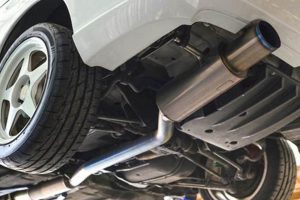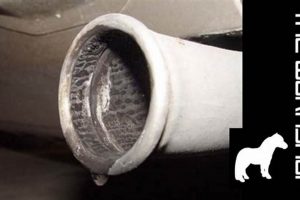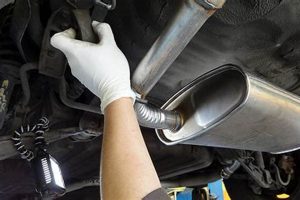A vehicle exhaust system component designed to amplify the audible output of the engine is often the focus of modification. These devices alter the sound characteristics, typically resulting in a louder and more aggressive tone. For example, a factory-installed component might produce a subtle hum, while an aftermarket alternative is engineered to create a pronounced roar.
The perceived value of these modifications is multifaceted. Some enthusiasts appreciate the enhanced auditory feedback, viewing it as a performance indicator. Others seek to express individuality through their vehicle’s sound profile. Historically, alterations to exhaust systems were frequently undertaken to improve engine performance, although modern systems often prioritize aesthetics and sound.
The following sections will delve into the regulatory aspects, potential performance implications, common types, installation considerations, and legal ramifications associated with these automotive modifications.
Guidance on Modifications to Vehicle Exhaust Systems
The following outlines key considerations when modifying a vehicle’s exhaust system for increased sound output. Proceed with caution and diligence to ensure compliance and safety.
Tip 1: Understand Local Regulations: Prior to any modification, thoroughly research and comprehend local noise ordinances and vehicle codes. Many jurisdictions have decibel limits and restrictions on exhaust system alterations. Failure to comply can result in fines or vehicle impoundment.
Tip 2: Evaluate Potential Performance Impact: While a louder exhaust system may subjectively feel like a performance enhancement, consider consulting with a qualified mechanic to assess its actual impact on horsepower and torque. In some cases, improper modifications can negatively affect engine efficiency.
Tip 3: Choose Reputable Manufacturers: Select aftermarket components from established and well-regarded manufacturers. These companies often invest in research and development to ensure product quality and compatibility with specific vehicle models. Avoid generic or unbranded parts.
Tip 4: Consider Professional Installation: Unless possessing advanced automotive mechanical skills, opt for professional installation. An experienced technician can ensure proper fitment, sealing, and alignment of the new exhaust components, minimizing the risk of leaks or damage.
Tip 5: Maintain Original Emission Controls: Ensure that any exhaust system modification does not compromise or remove original equipment manufacturer (OEM) emission control devices such as catalytic converters. Tampering with these systems is illegal in many regions and can result in significant penalties.
Tip 6: Document all Modifications: Keep detailed records of all exhaust system alterations, including receipts, manufacturer specifications, and installation dates. This documentation may be required for vehicle inspections or when selling the vehicle.
Tip 7: Regularly Inspect the System: Conduct routine visual inspections of the exhaust system to check for leaks, corrosion, or loose connections. Address any issues promptly to prevent further damage or potential safety hazards.
These guidelines emphasize the importance of responsible and informed decision-making when considering alterations to a vehicle’s exhaust system. Prioritizing legality, performance, and safety is paramount.
The subsequent sections will explore specific examples of common exhaust system modifications and their practical implications.
1. Legality
The legality of an exhaust system modification, particularly one resulting in increased sound output, is governed by a complex interplay of federal, state, and local regulations. These regulations primarily aim to control noise pollution and ensure vehicles meet established environmental standards. The direct consequence of exceeding permissible noise levels is often financial penalties, but repeat offenses or egregious violations can lead to vehicle impoundment or even legal action. For instance, many municipalities have decibel limits enforced through stationary testing or roadside inspections. A vehicle equipped with an aftermarket component that exceeds these limits is in violation. The importance of adhering to legality resides in maintaining community tranquility and upholding environmental responsibility. Failure to do so reflects negatively on both the individual and the automotive enthusiast community.
Further complicating the matter is the variance in enforcement practices. Some jurisdictions prioritize noise enforcement, while others focus on emissions compliance. Certain states mandate periodic vehicle inspections that include noise level checks, while others rely on citizen complaints to trigger investigations. A real-life example can be seen in California, where strict vehicle codes and emissions standards necessitate that any aftermarket exhaust system be certified as compliant with the state’s regulations. This requires manufacturers to undergo extensive testing to demonstrate that their products do not increase emissions or exceed noise limits. The practical application of this understanding is that vehicle owners must carefully research and select components that are explicitly approved for use in their specific location.
In conclusion, the connection between exhaust modification and legality is paramount. Ignoring the regulatory landscape can result in significant consequences. Understanding local ordinances, selecting compliant components, and retaining documentation are essential steps to ensure responsible vehicle modification. The challenge lies in balancing the desire for enhanced sound with the obligation to adhere to legal standards and contribute to a sustainable environment. This necessitates a commitment to informed decision-making and responsible vehicle ownership.
2. Performance
The relationship between exhaust system modifications and vehicle performance is complex. While an amplified sound emanating from an altered muffler might subjectively suggest enhanced power, the actual impact on horsepower and torque requires careful consideration. Aftermarket components are frequently marketed as performance upgrades, but the tangible benefits depend heavily on the vehicle’s engine, existing exhaust system design, and the specific characteristics of the modification. In some cases, simply increasing the sound output can lead to a decrease in performance due to reduced backpressure negatively affecting engine efficiency, particularly in naturally aspirated engines.
The effect on performance is not uniform across all vehicles. Turbocharged engines, for instance, can often benefit from a less restrictive exhaust system, as it reduces turbo lag and allows for greater airflow. However, even in these applications, a balance must be struck between flow rate and backpressure to optimize engine performance. For example, an excessively large diameter exhaust pipe, while reducing backpressure, can decrease exhaust velocity, leading to slower spool-up of the turbocharger. Real-world dyno tests are essential to quantify the actual performance gains or losses resulting from any modification. Additionally, the location where the sound amplification occurs within the exhaust system is relevant. Changes closest to the engine will have more impact than changes further downstream.
In conclusion, the assumption that a louder exhaust directly translates to increased performance is often misleading. While certain modifications, when carefully chosen and properly implemented, can yield measurable gains, others might actually reduce engine efficiency. The pursuit of performance requires a data-driven approach involving thorough research, professional consultation, and objective testing. Ignoring these factors risks compromising both the vehicle’s performance and its compliance with legal standards. Understanding the trade-offs between sound amplification and engine optimization is paramount for responsible vehicle modification.
3. Materials
The materials used in the construction of a car exhaust system, particularly the muffler, directly influence its sound characteristics and durability. The choice of material impacts the amplitude and frequency of sound waves produced, subsequently defining the perceived loudness and tone. For example, stainless steel is favored for its resistance to corrosion and its ability to produce a brighter, more resonant sound. Aluminized steel, while less expensive, offers reduced corrosion resistance, potentially leading to premature failure and changes in sound quality over time due to degradation. The thickness and density of the material also contribute to the sound profile, with thicker materials generally resulting in a deeper tone.
Consider a performance vehicle modified with a titanium exhaust system. Titanium, known for its lightweight properties and high strength, also possesses unique acoustic qualities. An exhaust system fabricated from titanium typically produces a high-pitched, metallic rasp that is distinctly different from the rumble associated with stainless steel. Furthermore, the weld quality and overall design of the muffler influence the propagation of sound waves. Poorly executed welds or suboptimal internal baffling can create undesirable harmonics and reduce the efficiency of sound attenuation, leading to uneven sound levels and potential drone. The material composition therefore acts as a key determinant of the aesthetic and functional attributes of the muffler.
In summary, the material selection process in muffler design is inextricably linked to both performance and sound quality. Stainless steel, aluminized steel, and titanium each offer a unique blend of durability and acoustic properties. The choice of material must align with the desired sound profile and the intended operating environment to ensure longevity and compliance. Understanding these relationships is paramount for informed decision-making in vehicle modification and maintenance, balancing the pursuit of auditory enhancement with practical considerations of cost and long-term reliability.
4. Installation
Proper installation of an aftermarket muffler designed to increase exhaust sound is crucial for achieving the desired acoustic effect, ensuring optimal engine performance, and maintaining legal compliance. Inadequate installation can negate the intended benefits, compromise vehicle operation, and result in legal penalties.
- Compatibility Assessment
Prior to installation, verifying compatibility between the replacement component and the specific vehicle model is essential. Differences in exhaust system geometry, engine displacement, and emission control requirements can render an incompatible muffler ineffective or detrimental. Failing to confirm compatibility may lead to improper fitment, exhaust leaks, and reduced engine efficiency.
- Secure Mounting and Sealing
Properly securing the muffler to the exhaust system using appropriate hangers and clamps is vital to prevent excessive vibration and stress on the exhaust pipes. Sealing all connections with exhaust sealant ensures a leak-free system, preventing exhaust gases from escaping prematurely. Leaks can significantly diminish the intended sound amplification and potentially introduce harmful gases into the vehicle cabin.
- Alignment with Existing Components
The replacement component must align correctly with the existing exhaust pipes, catalytic converter, and oxygen sensors. Misalignment can create stress on these components, potentially leading to premature failure. Ensuring proper alignment also contributes to the overall sound quality and prevents unwanted resonances or vibrations.
- Consideration of Local Regulations
Local noise ordinances often dictate permissible sound levels for vehicles. Installation must take these regulations into account to avoid legal repercussions. Professional installation services typically possess knowledge of local regulations and can ensure that the modification complies with these requirements.
The successful integration of an aftermarket muffler designed for increased sound output hinges on meticulous installation practices. Proper compatibility assessment, secure mounting, alignment, and consideration of local regulations are all indispensable elements. These factors collectively influence not only the desired auditory effect but also the overall performance, safety, and legality of the modified vehicle.
5. Resonance
Resonance plays a critical role in determining the sound characteristics of a vehicle exhaust system, particularly concerning modifications intended to amplify sound output. It is a phenomenon where an object vibrates at its natural frequency when subjected to an external force or vibration. In the context of a component designed to increase volume, resonance directly affects the frequencies that are amplified and the overall tonal quality. Changes to the muffler’s internal structure or material composition alter its resonant frequencies, resulting in a distinct audible signature. For instance, a longer muffler chamber may promote lower frequency resonance, producing a deeper, more bass-heavy tone, while a shorter chamber might emphasize higher frequencies, creating a raspier sound.
The design of aftermarket systems intended to increase sound often strategically manipulates resonance. By incorporating specific chamber sizes, baffle designs, and resonator configurations, manufacturers can fine-tune the frequencies that are emphasized. A practical example is a “straight-through” design that minimizes internal obstructions, allowing exhaust gases to flow more freely. This design tends to amplify higher frequencies and produces a louder, more aggressive tone. Conversely, a chambered design uses internal baffles to reflect sound waves, selectively attenuating certain frequencies and amplifying others, resulting in a more controlled and refined sound. Understanding these principles enables engineers to develop components that deliver a desired sound profile while minimizing undesirable effects like drone or excessive noise at specific engine speeds.
In conclusion, resonance is a fundamental principle governing the audible characteristics of an exhaust system. The manipulation of resonant frequencies is a key factor in the design of components intended to increase sound output. Achieving the desired sound profile requires a careful balance of material selection, chamber design, and baffle configuration. Comprehending the relationship between these elements and resonant behavior is essential for creating modifications that enhance the vehicle’s auditory presence while adhering to legal and practical considerations.
6. Backpressure
Backpressure, in the context of an internal combustion engine’s exhaust system and modifications intended to increase its sound output, represents the resistance to exhaust gas flow. Its manipulation, whether intentional or unintentional, significantly impacts engine performance, and therefore is directly relevant when considering modifications such as a component engineered to amplify sound.
- Definition and Measurement
Backpressure is defined as the pressure exerted by exhaust gases within the exhaust system. It is typically measured in pounds per square inch (PSI) or kilopascals (kPa) using a pressure gauge inserted into the exhaust stream. Higher readings indicate greater resistance to flow, while lower readings suggest a more free-flowing system. Baseline backpressure is specific to each engine and exhaust system design. Deviations from this baseline, particularly when seeking increased sound, can have consequences.
- Impact on Engine Performance
Excessive backpressure hinders the efficient expulsion of exhaust gases from the cylinders, leading to reduced volumetric efficiency, lower horsepower, and decreased fuel economy. Conversely, insufficient backpressure can also be detrimental, particularly in naturally aspirated engines. Scavenging effect is reduced if backpressure is decreased. Exhaust system design needs to optimize exhaust flow, minimizing the cylinder pressure.
- Component Design and Backpressure
The design of an exhaust system component intended to increase sound dramatically affects backpressure. A straight-through design, characterized by minimal internal obstructions, typically reduces backpressure. Chambered designs or those with significant baffling increase backpressure due to the restricted flow path. Choosing an appropriate design balances acoustic goals with engine performance requirements. Component specifications and design need to optimized or designed.
- Legal and Environmental Considerations
Modifications affecting backpressure can have implications for emissions compliance. Altering the exhaust flow dynamics may compromise the functionality of catalytic converters or other emission control devices, potentially leading to increased pollutant output. Regulations often restrict modifications that significantly alter backpressure due to environmental concerns and associated penalties. Therefore, responsible modifications need to comply with regulations.
In summary, backpressure is a critical parameter in exhaust system design, and any modifications intended to amplify sound must consider its potential impact on engine performance and emissions. Choosing components that strike a balance between acoustic enhancement and engine efficiency is crucial. Ignoring the principles of backpressure can lead to performance degradation, increased emissions, and legal repercussions when altering an exhaust system for increased sound output.
Frequently Asked Questions
The following addresses common inquiries regarding the modification of vehicle exhaust systems for increased sound output. These responses aim to provide clear and accurate information to assist in informed decision-making.
Question 1: Is increasing the volume of a vehicle exhaust system illegal?
The legality is dependent on local noise ordinances. Many jurisdictions have decibel limits that vehicles must adhere to. Exceeding these limits can result in fines and other penalties. It is imperative to research and comply with all applicable regulations prior to modifying an exhaust system.
Question 2: Will a component designed for enhanced exhaust sound increase engine horsepower?
Not necessarily. While some modifications can improve exhaust flow and potentially increase horsepower, others may have little to no effect or even decrease performance. The actual impact depends on the engine design, the existing exhaust system, and the specific characteristics of the modification. Dyno testing is recommended to quantify any performance changes.
Question 3: What materials are commonly used in aftermarket exhaust components and how do they affect sound?
Stainless steel and aluminized steel are prevalent choices. Stainless steel offers superior corrosion resistance and generally produces a brighter, more resonant sound. Titanium is used for lighter weight and generates a unique high-pitched metallic rasp. The choice of material significantly influences both the durability and acoustic properties of the system.
Question 4: Can I install an aftermarket muffler myself?
While some individuals with automotive mechanical experience may be capable of self-installation, professional installation is generally recommended. Proper fitment, sealing, and alignment are crucial for optimal performance and to prevent exhaust leaks. Incorrect installation can compromise the vehicle’s operation and potentially create safety hazards.
Question 5: What is “drone” and how can it be avoided?
“Drone” refers to an undesirable low-frequency resonance that can occur at certain engine speeds. It is often caused by standing waves within the exhaust system. Drone can be minimized through careful selection of components, proper resonator placement, and sound-deadening materials within the vehicle cabin.
Question 6: Will modifying the exhaust system affect the vehicle’s emissions?
Potentially, yes. Tampering with or removing original equipment manufacturer (OEM) emission control devices, such as catalytic converters, is illegal in many regions. Modifying the exhaust system can also alter the engine’s air-fuel ratio, which can affect emissions. Ensure that any modifications comply with all applicable emissions regulations.
The information provided serves as a general guide. Consulting with qualified automotive professionals is advisable for specific applications and to ensure compliance with all applicable regulations.
The following section will summarize the key considerations for responsible exhaust system modification.
Car Loud Muffler
The preceding exploration of “car loud muffler” modifications reveals a complex interplay of legal, performance, material, and installation factors. The pursuit of amplified vehicle sound necessitates careful consideration of local ordinances, potential engine performance impacts, material selection, and installation practices. Ignoring these aspects can result in legal repercussions, compromised vehicle operation, and undesirable auditory characteristics. A responsible approach requires a comprehensive understanding of resonance, backpressure, and emissions implications, ensuring modifications align with both performance goals and regulatory requirements.
The selection and implementation of modifications for enhanced sound remain the sole responsibility of the vehicle owner. Given the potential ramifications, engaging qualified professionals for guidance and installation is strongly advised. A future outlook on these modifications suggests an increase in regulatory scrutiny and a greater emphasis on sustainable practices within the automotive aftermarket. Therefore, a proactive approach, prioritizing compliance and informed decision-making, is essential for all vehicle enthusiasts and owners considering such alterations.







